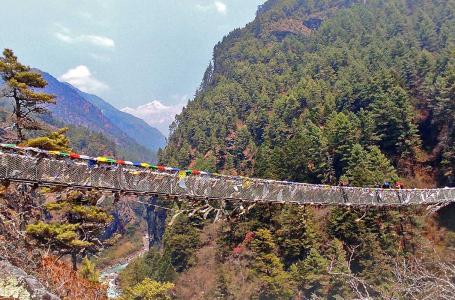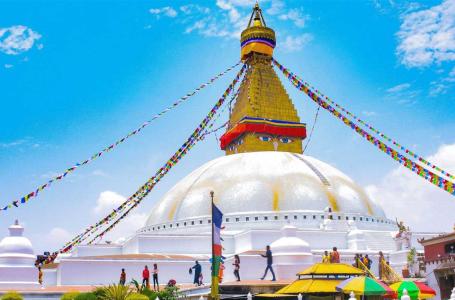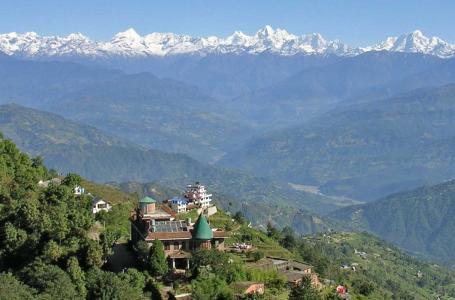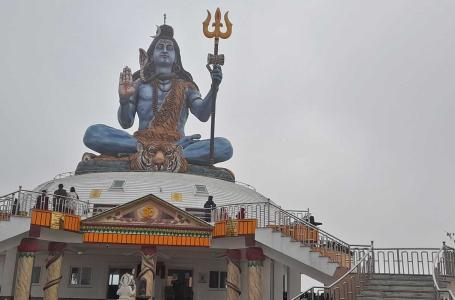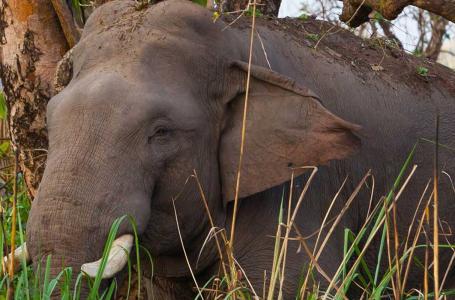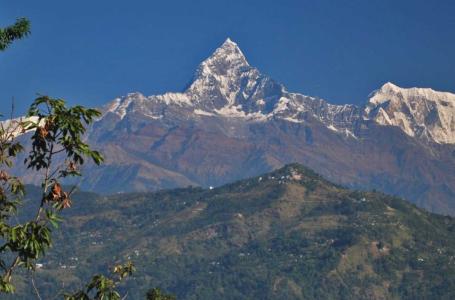Not many people pluck up the courage to challenge the legend of Kanchenjunga.
Mount Kanchenjunga is the third-highest peak in the world. Because of its no-easy accessibility and difficult terrain, only a handful have summoned up the courage to explore this region. But, whosoever traveled across this region found themselves as one of the luckiest few people to stumble across what mountains are.
Kanchenjunga, also known as the "five treasures of snow", remains hidden until you are an inch away from it. The defying outlook of the black Makalu seems to follow you for most of the part, but getting a perfect view from the top of the Kanchenjunga is still left behind. You need to get up again and again, on your own, to finally arrive at the destination. While the highlights of exploring the Kanchenjunga region are its mountains, the views of the brilliant waterfalls, deep valleys, raging rivers, and icy glaciers cannot be overlooked as these are what endorses the beauty of Kanchenjunga in the subconscious.
Kanchenjunga Trek is an exhilarating adventure option, promising breathtaking natural beauty and a profound connection with the Himalayan nature. Begin your adventure by performing extensive study about the path, permits, and the trek's particular obstacles using guidebooks, online resources, and travel forums. Get the appropriate permissions and choose the ideal hiking seasons.
Choose an itinerary that is appropriate for your fitness level and interests, with the conventional Kanchenjunga Circuit normally lasting 20-25 days. And if you are trekking alone, hire a guide because solo travel is prohibited in Nepal for foreigners. You can also hire a Porter to help with the burden of carrying gear, which is a reasonable option given the rough terrain. Pack with care, including necessary hiking gear appropriate to the tough circumstances.
Adopt ethical hiking methods to protect the Kanchenjunga region's rich indigenous culture and fragile ecosystem. Given the difficult terrain and high elevations, adequate physical fitness and acclimatization are essential. Carry an emergency contact list with you for safety, and immerse yourself in the pristine Himalayan terrain, diverse sceneries, and distinct culture of the indigenous villages met on this spectacular walk. Thorough planning and local supervision are required for a successful and memorable Kanchenjunga hike.
The ideal times to hike to Kanchenjunga, Nepal's captivating and lonely location, are unquestionably spring and autumn. Spring, from March to May, and fall, from September to November, provide the most pleasant and magical hiking conditions.
The weather in spring is moderate and consistent, with comfortably warm days and delightfully chilly evenings. Rhododendron woods burst into blossom, interlaced with an assortment of wildflowers, adorning the environment with a bright spectrum of hues. This natural wonder provides a beautiful backdrop for your journey, and clear skies provide unhindered views of the neighboring Himalayan peaks.
Autumn, on the other hand, has consistent weather, with pleasant daytime temperatures and crisp, energizing nights. The monsoon rains thoroughly cleared the environment, providing crystal-clear vistas of the beautiful mountains and creating a perfect hiking scenario. The trails are in excellent shape, providing a great overall hiking experience.
However, avoid the monsoon season, which lasts from June to August and is characterized by severe rains and treacherous trail conditions. Similarly, the winter months of December to February may be difficult, with freezing temperatures and potential snowfall making certain regions inaccessible.
The accommodations and food choices along the Kanchenjunga trip in Nepal are simple and utilitarian, reflecting the isolated and difficult nature of this hiking path. Teahouses and simple lodges will be found tucked in the communities along the path, providing crucial shelter for the trek. Teahouses generally provide twin-bedded rooms with minimal bedding, and restroom facilities shared by hikers. Some lodges provide rooms with connected toilets for guests wishing a little more solitude, albeit amenities are limited.
Food selections are similarly modest yet healthy, meant to give nutrition for a trekker's strenuous journey. The menu is generally comprised of Nepali and Tibetan foods, with rare foreign offerings. Trekkers may sample traditional Nepali fare such as dal bhat, momo, and Thukpa, as well as Western-style fare like as spaghetti and pizza, though the latter may be more expensive. It's crucial to remember that owing to the trek's remoteness, food options may be limited, and it's best to avoid fresh vegetables and salads to prevent the risk of foodborne disease. Choosing prepared and hot meals is a wise decision.
It is highly recommended to consult your guide for better and hygienic food choices.
The trek to Kanchenjunga usually starts at Biratnagar or Bhadrapur. You may take a direct connecting flight from Kathmandu to Biratnagar. After arriving in Biratnagar, you can take a shared or private vehicle to Surkhet. Once you arrive in Surkhet, our adventure will begin on foot, passing by various natural and cultural attractions including stunning landscapes, historical monuments, and temples along the way.
This walk will come to a close after you return to Surkhet, from where you may fly or take a shared/public car back to Biratnagar. After reaching Biratnagar, a direct connecting flight will be ready for you to return to Kathmandu.
Permits for trekking or climbing in the Kanchenjunga region of Nepal are crucial, as they ensure that you are legally allowed to enter the area and help support conservation efforts in the region. Kanchenjunga is one of the restricted trekking areas in Nepal, and these permits are only provided by licensed agencies, and no freelancer guides are authorized to give them out.
1. Restricted Area Permit(RAP):
To enter the Kanchenjunga Conservation Area, you require a unique "Restricted Area Permit". The immigration department in Kathmandu issuing this permit. When traveling to this area, it is required that you work with a licensed trekking service and be in a group with at least two other hikers.
Cost: USD 10 per person for a week
2. Kanchenjunga Conservation Area Permit (KCAP):
In addition to the restricted area permit, you will also need a "Kanchenjunga Conservation Area Permit," commonly referred to as KCAP.
Cost: Nrs 2000 per person and there is no extra charge for extended days.
(All the permits are included in this package)
Our adventure to Kanchenjunga Trek will begin with a flight from Kathmandu to Biratnagar. Our staff will greet you at your hotel and transport you to Tribhuvan International Airport for our scheduled trip to Biratnagar. The flight lasts around 45 minutes to an hour. After arriving at Biratnagar airport, we will take a taxi or private vehicle to a hotel where we will rest for the day or tour Biratnagar for a bit.
We'll get up early and eat breakfast before flying to Suketar. We will take a domestic flight to Suketar Airport after arriving at the airport. Suketar Airport is the closest to the Taplejung area, which serves as the starting point for numerous treks in the region, including the Kanchenjunga Base Camp trip. We will prepare for our trek to Mitlung after arriving in Surkhet, which will take around 6 hours. The trip from Suketar to Mitlung is a scenic and demanding journey across different landscapes and rural communities in Nepal's eastern region.
We'll begin our descent from Suketar, passing through verdant woodlands and terraced farms. The route passes through a few small towns and provides views of the surrounding hills and valleys. After some hiking, we will arrive at Mitlung, which is surrounded by lush greenery, terraced farms, and stunning hills. This hamlet gives us a taste of rural Nepalese life and culture. This will also be our day's stop.
We'll start our adventure early and eat breakfast. The path from Mitlung to Chirwa goes through beautiful woodlands and numerous tiny settlements. As you rise and descend the mountainous landscape, we will cross rivers and go past terraced farms. This walk normally takes 5 to 7 hours, depending on the pace of the trek and the path conditions.
The route also provides us with fresh picturesque vistas as well as an opportunity to learn about the distinct culture and lifestyle of the region's local towns. We'll find a hotel to stay in once we get to Chirwa. The village provides an opportunity to meet with friendly inhabitants and learn about the ethnic communities who live in the area's culture and customs. Chirwa's residents are noted for their great hospitality.
The trip from Chirwa to Sekathum takes us through stunning scenery, including lush woodlands and terraced farms. We will begin our day with breakfast before departing for Sekathum, which will take roughly 5 to 7 hours. When we get to Sekathum, we will reserve a hotel for the day and rest.
We shall start our journey to Amjilosa on this day. We'll begin our trek after a little break and begin our hike. The walk leads us through a variety of scenery, such as lush woodlands, rhododendron forests, and terraced farms. We will stop in various small villages along the journey to enjoy the local culture and connect with the friendly inhabitants.
The route steadily ascends, and we will pass suspension bridges across rivers, adding an element of adventure to the journey. This journey usually takes 6 to 8 hours. When we get to Amjilosa, we will book a hotel for the day.
After breakfast, we will begin our journey from Amjilosa to Gyabla. The Ghunsa River is followed by the route, which continues through deep rhododendrons and bamboo woods. We will pass multiple suspension bridges across rivers and streams as we rise, giving an exciting aspect to the walk.
The walk provides panoramic vistas of snow-capped Himalayan peaks, including the spectacular Kanchenjunga, the world's third-highest summit. This 5- to 7-hour trip traverses through tiny communities and provides an opportunity to connect with locals, gaining insights into their distinct culture and way of life. We will arrive in Gyabla, our final stop for the day, after continuing our journey.
We'll leave early after breakfast and make our way to Ghunsa. This is a pretty long trip, but it rewards you with a breathtaking view of the landscape and mountain views. The route takes us past charming towns, terraced farms, and deep woodlands.
The environment will alter as we gain height, and we will notice a difference in vegetation. Continuing on, the route leads us into a beautiful valley with breathtaking views of the Alps. We will eventually arrive at Ghunsa, a secluded yet picturesque Himalayan settlement. We'll pick a hotel and spend the night there.
We are currently at a greater height and intend to continue ascending. So we take advantage of the chance to unwind and acclimate in Ghunsa.
Read a book, meditate, or simply enjoy the peace and quiet. Allowing your body enough rest is essential for a successful hike at higher elevations. We'll also conduct some brief sessions of breathing exercises or yoga to help with acclimation.
We will begin our journey to Kambachen on this day after a deserved breakfast. This trail starts with us walking along the Ghunsa River route. The route winds through lovely rhododendrons and pine forests, with glimpses of snow-capped peaks here and there. As we hike through will arrive at a lush glacier valley by taking a gently ascending path.
The route continues beyond a waterfall to a landslide-prone region where we exercise extreme caution. After a time, we will arrive at Sele Le, which marks a significant milestone on the path and provides beautiful panoramic views of the surrounding mountains. We will descend from Sele Le to the village of Kambachen. If we're lucky, we could see blue sheep and snow leopards. This village will also be our overnight stop.
Today's trek mostly takes us over the moraine from the Kanchenjunga Glacier. Walking uphill over enormous stones, we get breathtaking vistas on both sides. As you reach the Lhonak Glacier, the route winds through mountains and rugged terrain. And, because we are in Snow Leopard country, we keep a lookout for this uncommon species as well. After continuing for a while, we will arrive at the village of Lhonak and look for a place to stay.
We'll be traveling south from Lhonak today, following the Kanchenjunga Glacier. The path winds across a rugged and challenging area, including moraines and glaciers to traverse. The path gains height as we reach Pang Pema. We will eventually arrive at Pang Pema Base Camp after a long journey. The Pang Pema camping offers spectacular views of the Kanchenjunga mountain as well as surrounding peaks such as Wedge Peak and The Twins. We'll settle her in for the day.
Because of the great altitude, it is important to relax at Pang Pema. We may explore the region surrounding the base camp, take pictures, and enjoy the quiet splendor of the Himalayas during our stay.
Our Journey to Kanchenjunga base camp has finally come to an end, so for today, we will descend our way to Kambachen. From Pang Pema, we will retrace your steps back towards Lhonak. The route involves descending over moraines and rocky terrain.
As we reach Lhonak, we can take a short break in this high-altitude village and enjoy the view. Continuing this trail, we will descend further. As we walk through the rugged terrain of the Kanchenjunga region. Finally, we will arrive back in Kambachen, where you can rest and celebrate the completion of your trek.
After acclimatizing Kambachen, we will go off on our journey to Ghunsa. The route drops in elevation as we pass through alpine trees and harsh terrain. We'll also see the Lhonak Glacier and marvel at the breathtaking vistas of the surrounding peaks. Ghunsa is a lovely community that combines Tibetan and Nepali cultures.
The route continues through the lovely woodlands and follows the Ghunsa River from Ghunsa. We will drive through little communities and terraced farms on our way to Phale which is a tiny and less-visited village, so we will enjoy a more calm atmosphere. After reaching Phale, we will settle and find a hotel to stay in for the night.
After a well-deserved breakfast, we will begin our descent into Amjilosa. This hike takes us through lush forests and follows the Ghunsa River, providing a beautiful blend of natural beauty, cultural discovery, and an escape into the tranquillity of the Himalayas. We'll explore lush rhododendron and bamboo woods, with views of stunning waterfalls and snow-capped hills in the distance.
We will pass via the village of Gyabla on our route to Amjilosa, where we may take a brief stop and rest. We'll now head downwards till we reach the picturesque town of Amjilosa. This community is surrounded by terraced fields and provides insight into the traditional way of life of the locals. This will also be our stop for the day.
We will descend via lovely woodlands, terraced farms, and little villages beginning at Amjilosa. We'll stroll alongside the Tamur River, taking in the scenery along the route. The walk provides a panorama of the local culture and way of life.
We will travel to Chirwa through the Ghunsa Khola Valley, which is home to tiny towns and lush farmlands. The path descends further, passing through more villages and terraced fields, as well as lovely residences, monasteries, and prayer flags flapping in the air. Finally, we will arrive in Chirwa, a lovely community with a diverse range of cultures and traditions. We'll spend the day resting in a tea house.
We'll embark on a journey to Linkhim as soon as we finish our breakfast. Then we'll begin by climbing through Diwa village. The path winds through stunning scenery and rural communities. The route descends into a wide side canyon before ascending up to the ridge and arriving at Linkhim, our destination for the day.
The path from Linkhim travels through side valleys to the Limbu settlement of Phurumbu and a peak overlooking a massive landslide before Jogidanda. It is a 3-4 hour climb past the Sherpa settlements of Bung Kulung and Bhote Gaon and leads to the Suketar airstrip. We'll stay at a hotel here for the night before heading to Biratnagar.
Finally, the day has arrived for us to travel back to Kathmandu. After breakfast, catch a flight back to Biratnagar. After reaching Biratnagar Airport, we will take another domestic aircraft back to Kathmandu. Relax and take in the scenery as we soar over the skies. When we arrive in Kathmandu, we will take a vehicle to your accommodation or depart from the international airport.
Trip Start and End Point
Kathmandu / Kathmandu
| DATES | STATUS | PRICE | SPACE LEFT | ||||
|---|---|---|---|---|---|---|---|
|
Start date: 25-Apr, 2025
End date: 13-May, 2025 |
Guaranteed | USD 2170 |
1
|
Book Now | |||
|
Start date: 21-May, 2025
End date: 08-Jun, 2025 |
Guaranteed | USD 2170 |
2
|
Book Now | |||
|
Start date: 05-Jun, 2025
End date: 23-Jun, 2025 |
Guaranteed | USD 2170 |
2
|
Book Now | |||
|
Start date: 16-Aug, 2025
End date: 03-Sep, 2025 |
Guaranteed | USD 2170 |
2
|
Book Now | |||
|
Start date: 05-Sep, 2025
End date: 23-Sep, 2025 |
Guaranteed | USD 2170 |
2
|
Book Now | |||
|
Start date: 05-Oct, 2025
End date: 23-Oct, 2025 |
Guaranteed | USD 2170 |
2
|
Book Now | |||
|
Start date: 07-Nov, 2025
End date: 25-Nov, 2025 |
Guaranteed | USD 2170 |
1
|
Book Now | |||
The Kanchenjunga region is one of Nepal’s most remote and least-explored trekking destinations, offering untouched wilderness, diverse landscapes, and close-up views of the world’s third-highest peak, Mount Kanchenjunga (8,586m).
The trek features dense rhododendron forests, glacial valleys, high-altitude passes, and alpine meadows, with a chance to see red pandas, Himalayan black bears, blue sheep, and rare birds in the Kanchenjunga Conservation Area.
The trek has basic teahouses in some villages, but due to its remote nature, trekkers should be prepared for camping in isolated sections where lodges are unavailable.
The trail passes through traditional Limbu, Rai, and Tibetan villages, where trekkers can experience unique local customs, monasteries, traditional dances, and authentic Himalayan hospitality.
This trek involves long trekking days, high-altitude climbs, and remote trails, making it perfect for experienced trekkers seeking solitude, unspoiled nature, and a true Himalayan adventure.

